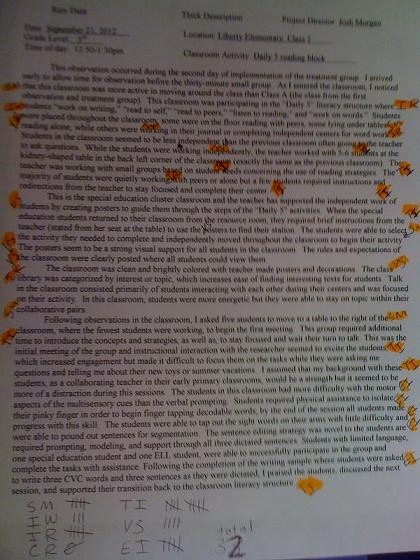Implementation of project: Initially, during this research project, I strived to maintain the structure of my lessons, the schedule of sessions, and to exhibit some kind of control on the environment but this been mostly impossible. There have been various changes made to the action research project that were required by circumstance but were unplanned. This week one of my groups of students requested to work outside of my classroom at a table rather than in their classroom because it was distracting. I allowed this to help the students focus but later felt that this would add an additional variable into the research student that was not planned for. This change has been documented but should I change pull the other group from their classroom to the table to ensure consistency across the treatment groups? I decided to offer this opportunity to the student in the second group and they agreed with their peers and wanted to work in the hall. This issue will need to be taken into account the next time I run this intervention strategy in a classroom.
Implementation of project: As I entered the classroom, students were station at various areas around the room engaging in their “Daily 5” instructional activities: some reading to peers, others making words independently, and some reading alone. I walked over to interrupt each of the students during their center to ask them to come to our “writing group.” Each of the students was excited to come to the group and jumped up quickly to put away their materials. Some students forgot to put their materials away and needed to be redirected. As I contacted each student I asked them to move slowly towards the door and to wait outside the doorway. I learned my lesson from the first day that if I simply ask them to meet me at the door they some will run and yell to get their peers to come with them.
Once in the hallway, walking toward out table in the all (as the students requested), I asked them about their day and all of them began to talk at the same time. I asked them to slow down and take turns. The students told me about getting a new bike, going to see their family over the weekend, and all about their summer vacation. They were excited to get the chance to talk to a teacher they rarely see in their classroom.
Arriving at the table, students were able to choose their seat and sit without prompting. Once seated, they continue their conversation with me until I interrupted stating that we need to get started. To promote compliance with group expectations, on the second session with the group, I offered a short reward at the end of the group if time allowed, playing catch with a soccer ball. The students are excited to get this reward and are much more focused during the session.
I begin the lesson by briefly reviewing the phonics skills, sight words, and number of words in dictated sentences before instruction. Students are impressed to find out they are working on five-word sentences. One student states, “I want to write a sentence with 100 words!” I encouraged him to learn how to write longer sentences and noted that some sentences can be too long and will not make sense. We begin instruction by practicing dictation with three phonetic words on the back of the sheet. I state the word, model segmenting the word, and write the word. Students follow the process and segment and write the same word then check it on my paper. This happens with each word. Students are becoming much more fluent with the segmenting strategy and are completing the words much quicker. We then practice sight words by tapping the words on our arm and stating the letter names then the word three times. Students are becoming more comfortable with this strategy and are able to write the words using the strategy. Following the practice words, I advise students to flip over the paper and write their name. This begins the structured sheet completed during each session. We segment each of the three other phonetic words using the “tap out” strategy beginning with the pinky finger then ring, then middle finger to symbolize the three sounds. After the initial writing of each word, students check their work with my model paper and then write the word again while stating the letter names.
Following the word dictation, three sentences are dictated individually to the students while all pound out the words to segment the sentence with fist on the table. Students then segment the sentence while touching the lines on the sheet for each word. They write the sentence independently while I write the sentence on my model paper. They are able to use this for a reference if needed. As a group, we use the “COPS” sentence editing strategy to edit each sentence, they check their work on my sheet, and rewrite the sentence without broken lines to generalize spacing and line orientation skills. This happens three times.
Following the instruction, we discuss the next session and play catch if there is time.
Attachments:










